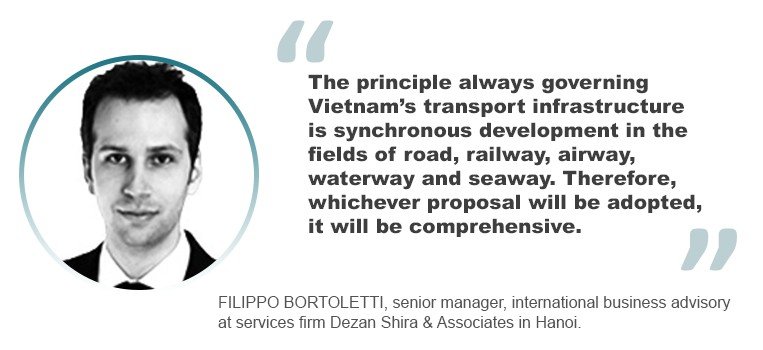Vietnam is gearing up for a massive road-led expansion of its transport infrastructure, under its new Law on Private Public Partnership (PPP law), official media has reported.
The three-option strategy outlined by the Ministry of Planning and Investment’s Development and Strategy Institute is priced as high as US$65 billion and would be built by 2030, but is expected to last Vietnam until 2050.
Proposal One, priced at between US$39 billion and US$43 billion, will include 5,000 kilometers of expressway; completion of Long Thanh International Airport; Lach Huyen, a deepwater port in the northern city of Hai Phong; and high-speed railroad routes between Hanoi and Vinh and Ho Chi Minh and Nha Trang.
Some details are notable. Long Thanh, located 25 km east of Ho Chi Minh city, is projected to become the largest airport in Vietnam, serving most or all of the international flights to the southern city. Lach Huyen is one of the first public-private partnership (PPP) projects between Vietnam and Japan; its growth will be dramatic but likely not enough, as the port will be able to take container ships up 6,000 TEU, with the potential for 8,000 TEU ships, despite the industry norm now being much larger.
A second proposal considered a "breakthrough," not just because of its US$43 billion to US53 billion cost. This project also includes 5,000 kilometers of expressway and two high-speed railways; it also includes railways connecting Lach Huyen Port and the International Container Terminal Tan Cang-Cai Mep in Ba Ria-Vung Tau Province with Ho Chi Minh City.
This proposal also includes renovation of a road and railway bridge across the Duong River in Hanoi, dredging waterways between Hai Phong City and Phu Tho Province to serve container ships and upgrading the Cho Gao Canal linking Ho Chi Minh City and the Mekong Delta as well as Cai Mep. Unlike the first proposal it has more extensive airport facilities with completion of the second phase of Long Thanh, third terminals for Ho Chi Minh City’s Tan Son Nhat and Hanoi’s Noi Bai airports and expansion of Dien Bien airport.
The third proposal is the most expensive at US$61 billion to US$65 billion and extends the first proposal to include railways in different parts of the country, according to official reports.
“The ministry said the master plan is targeted at letting the traffic infrastructure system achieve a cargo transportation capacity of 4.4 billion tons per year, which will rise 6.8% annually,” one report added. Neither the ministry nor its Institute responded when asked for comment by Asia Cargo News.
“There is no clue on which of the three proposals is currently favored,” said Filippo Bortoletti, senior manager, international business advisory, at services firm Dezan Shira & Associates in Hanoi.
Against that, other ideas are being suggested with Dang Huy Dong, former deputy Minister of Planning and Investment, recently saying that Vietnam should pay more attention to developing railways to boost cargo transportation as it would help to save more logistics costs compared to road transportation, Bortoletti added.
“In general, the principle always governing Vietnam’s transport infrastructure is synchronous development in the fields of road, railway, airway, waterway and seaway. Therefore, whichever proposal will be adopted, it will be comprehensive,” he added.
It will also be done under Vietnam’s new PPP law, and besides the new roads and other facilities, maybe even trains, there is significant new software backing up the hardware, although it doesn’t go as far as some had hoped.
“That said, the new legal framework brought some very welcomed improvements compared to Decree 63, especially in the procedure for selecting investors, by lowering the minimum equity capital from 20% of total investment capital to 15%, and by introducing revenue (and risk) sharing mechanisms,” Bortoletti added.
These, but especially the new revenue sharing mechanisms introduced by the new law, could offer a major boost to PPP projects with market risk, such as toll road/rail projects, he said.
“However, there are still improvements which can be made. One of the main bottlenecks is that the current legal framework (like the previously issued regulations) fails to regulate the process to grant security over statutory land interests. As result, security over land use rights is still regulated by the land law, which imposes restrictions on foreign lenders taking security of land use rights and immovable assets.” he said.
On top of this, the new law removed a reference to step-in rights allowing lenders to be protected in case of default of the project company and the choice of foreign law as the governing law in PPP projects is no longer permitted.




